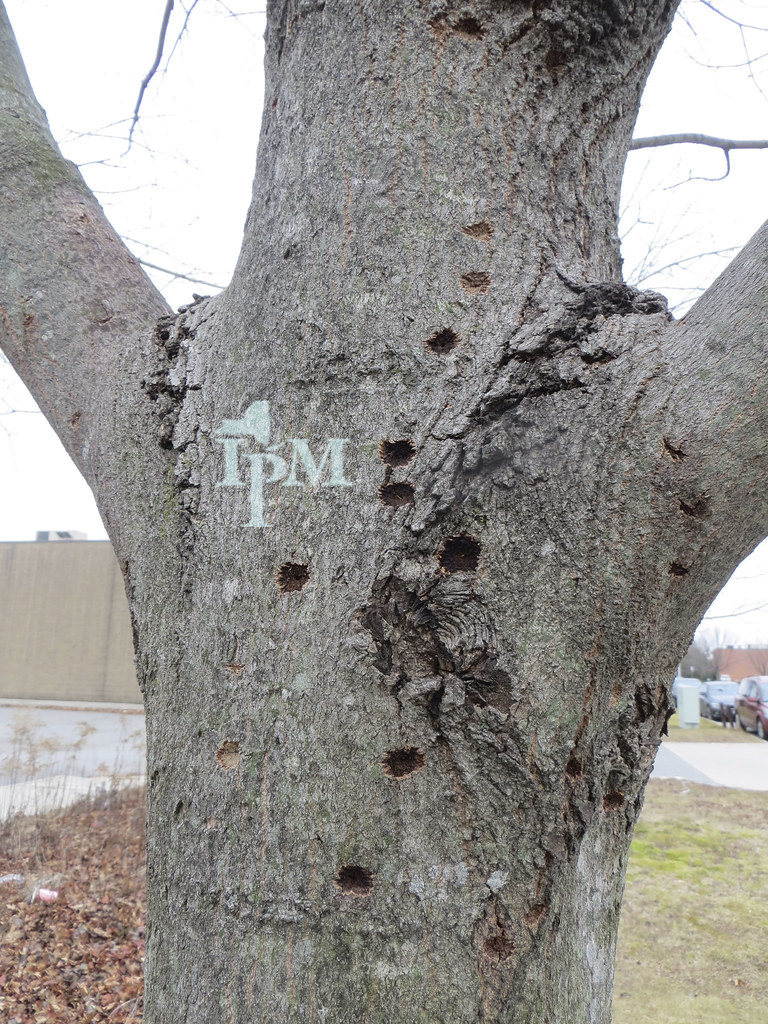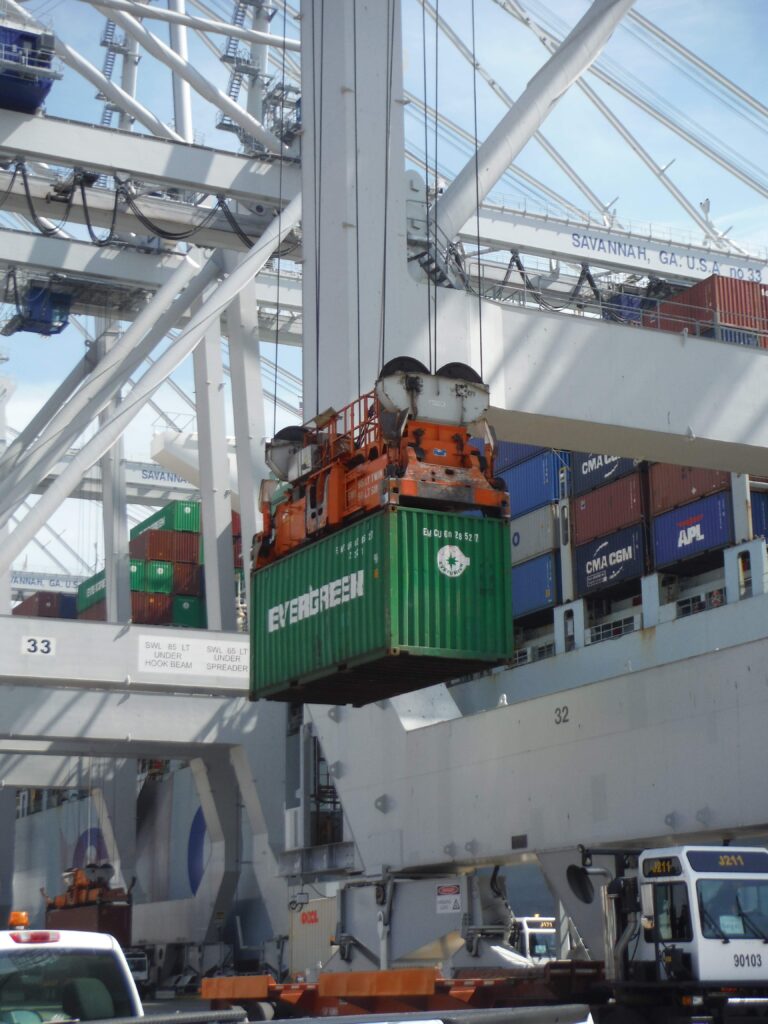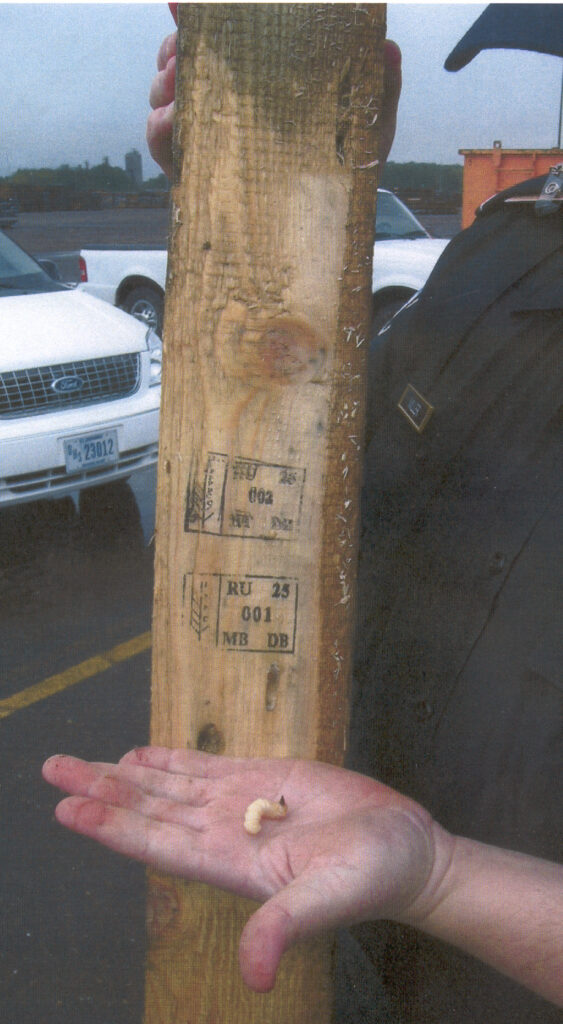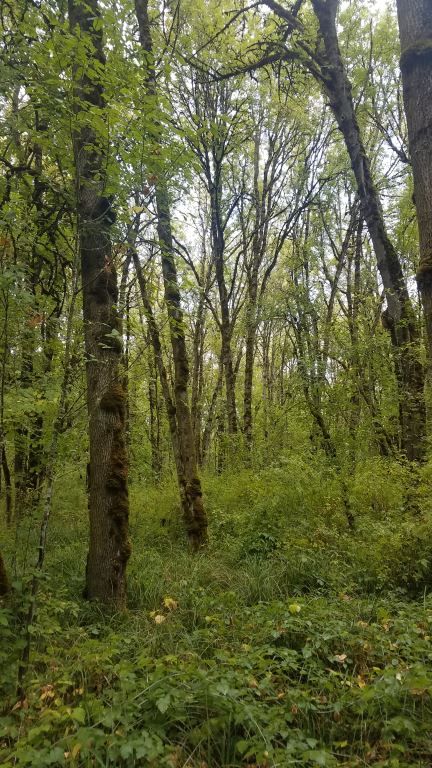As we know, wood packaging (SWPM; crates, pallets, spools, etc.) is a high-risk pathway for introduction of bark- and wood-infesting insects (borers). (To see my 40 earlier blogs about wood packaging material, scroll down below archives to “Categories,” click on “wood packaging”.) Examples of highly damaging pests introduced to North America include Asian longhorned beetle; emerald ash borer; redbay ambrosia beetle; sirex woodwasp; possibly the polyphagous and Kuroshio shot hole borers; Mediterranean oak borer; and dozens of others. (As of 2014, 58 new species of non-native wood- or bark-boring insects had been detected in the past 30 years [Leung et al. 2014]).
The Asian longhorned beetle and emerald ash borer were probably introduced before the World Trade Organization (WTO) came into effect in 1994; many of the others were detected – if not introduced – after that date. This global trade agreement not only facilitated rapid growth in trade volumes; it also imposed stringent conditions for adoption of plant health (= phytosanitary) measures aimed at preventing pest introductions. (For a review of the WTO restrictions, see my Fading Forests II report, here).
While the risk of pests travelling in raw wood was well known, U.S. and international phytosanitary agencies became aware that wood packaging fit into that category with detection of the ALB in New York and other wood-borer introductions. They acted remarkably rapidly to reduce this risk by negotiating and adopting International Standard for Phytosanitary Measures (ISPM) #15 in 2002.

The goal of ISPM#15 is to “significantly reduce” [not eliminate] the risk of pests associated with solid wood used for constructing packaging (e.g., crates, pallets), from being introduced to other countries through international trade.
This first international standard addressing a pathway of introductions was adopted 20 years ago. (The U.S. fully implemented ISPM#15 in 2006; see either article by Haack for a description of the phase-in period.) So – how great is the risk of pest introduction in wood packaging now? What proportion of these incoming containers are likely to be harboring tree-killing insects? Since it is impossible to reduce that risk to 0 while continuing trade using wood packaging, what is an acceptable level of risk? In determining that level, we must keep in mind the huge volumes of wood packaging being used in international trade, and the serious damage these wood-borers can cause. (See the pest profiles in the links provided above.)
I applaud the international phytosanitary community for acting fast and for choosing a pathway standard rather than try to differentiate the level of risk associated with any particular transaction – given that wood packaging could be made from dozens or hundreds of tree taxa, there are thousands of species of wood-boring insects, and the likelihood of an introduction depends in part on the exporting and importing countries. Plus, international trade involves huge volumes of goods. According to Haack et al. (2022), ~ 55 million TEU (shipping containers measured as twenty-foot equivalents) entered the U.S. in 2020. This is a 68% increase over the volume in 2003. Imports in the first half of 2020 were down because of the COVID epidemic. They then grew rapidly through the first half of 2022; imports from Asia in the first 10 months of 2022 were 21% higher than in the same period in 2019 (Mongelluzzo 2022). Haack et al. (2022) note that the number of countries from which SWPM originated more than doubled from 2003–2004 to 2010–2020, although it dropped after 2018.
In 2014, Haack et al. published an estimate of the pest approach rate in wood packaging as of 2009. Depending on which countries were included and how the time periods were selected to separate pre- and post-adoption of ISPM#15, they reported a 36–52% reduction in the SWPM infestation rate following ISPM#15 implementation. This resulted in an estimated infestation rate of 0.1% (1/10th of 1%). In a recent blog, I applied this estimated approach rate to find that probably 11,000 containers per year transported pests to North America in 2021; 80% of these shipments came to the United States.

Since 2009, traders have gained 13 more years of experience. More important, in 2009 the standard was changed to require that wood packaging be constructed from wood that had been debarked before treatment. There is a tolerance limit for small patches of residual bark. Given that bark provides shelter both for insects already there, and facilitates any new infestation after the treatment was performed, it was expected that this change would further reduce the pest risk.
Since more than a decade has passed since the original analysis, and wood-borers continue to be found in wood packaging – in the U.S. and elsewhere – Haack and colleagues have re-analyzed the pest approach rates (see Haack et al. 2022). Their objectives were to
(1) compare pre-and post-ISPM#15 borer-infestation rates;
(2) compare the borer detection rates individually for three kinds of imports and key US trading partners;
(3) see whether wood borer presence varies by season; and
(4) assess the diversity of borer taxa detected overall, and by cargo category and country of origin.
Over the entire 17-year period 2003 – 2020, 87,571 consignments met the conditions for the study: they contained wood packaging that bore the ISPM#15 mark (from 2006 and onwards) indicating it had been treated as required; and the shipment was not from Canada (the U.S. does not require wood packaging from Canada to comply with ISPM#15).
They analyzed the data for the entire 17-year period and separately for four phases:
1) before the U.S. implemented ISPM#15 (2003-2004);
2) phasing-in of U.S. implementation (2005 – 2006);
3) full implementation – but without any restriction on THE presence of bark (2007-2009); and
4) full implementation with restrictions on bark (2010 – 2021).
Over the period 2003– 2020, wood borers were detected in 180 of the 87,571 consignments, or 0.21%. This was 38% less than the 0.34% infestation rate in 2003-2004, before the U.S. implemented ISPM#15. Still, the US had required China to treat its wood packaging as of December 1998 because of introduction of ALB. However, the reduction was greatest in the first phase (2005-2006); in subsequent periods the pest approach rate inched back up. Detection rates have been relatively constant since 2005 despite the requirement in 2009 that bark be removed and a resulting reduction in the presence of bark (it fell from 40% or more of inspected consignments before 2009 to 15% after 2010).
Unfortunately, the data used in the study do not indicate if borers detected on wood were located under any bark that was present. There might be some indication from the species detected: 100% of Scolytinae identified to genus or species detected before 2007 were true bark beetles (which develop primarily under bark), but only 23% in 2010–2020 period.
The data revealed no strong seasonal pattern.
Types of Wood Packaging
The study findings indicate that crates are the type of wood packaging most likely to be infested by insects. While crates constituted only 7.5% of the wood packaging inspected, they made up 29.4% of the infested packaging – or four times greater than their proportion of the dataset. Pallets constituted 88.6% of the inspected wood packaging, but only 67.2% of the infested shipments. Dunnage and “other” wood packaging made up insignificant proportions of both total wood packaging inspected and wood packaging found to be infested. (Of course, dunnage can still pose a threat; see my blog about issues in Houston with dunnage bracing breakbulk cargo.) The Haack et al. (2022) study did not examine dunnage accompanying breakbulk shipments.
Records of Various countries
The 180 infested consignments originated from 30 countries. For two of these countries, the percentage of wood packaging found to be infested was higher than the proportion of all wood packaging from that country that was inspected. Packaging from China made up 4.6% of all shipments inspected, but 22% of the 180 consignments with infested wood packaging. Thus the proportion Chinese consignments with infested wood is five times greater than expected based on their proportion of the dataset. The rate of wood packaging from China that is infested has remained relatively steady – as I noted above. The Chinese infestation rate was 1.26% during 2003–2004, and ranged from 0.58 to 1.11% during the next three periods.
I remind you, again, that the U.S. has required treatment of wood packaging from China since December 1998. Why does this country continue to ship pest-infested wood packaging to the United States? Why are the responsible agencies in the United States not taking action to correct this problem? (DHS Bureau of Customs and Border Protection enhanced its enforcement in 2017; see my blogs.)
A second country with a record of non-compliant wood packaging – Italy – has done better. The level of pest detection still exceeded their expected proportional level – that is, Italy constituted 12.7% of all inspected shipments, but had 15% of infested consignments. Still, Italy has reduced detection rates by almost two-thirds over the 17 years of the study. The Italian statistics would have been even better if there had not been a spike of infested wood in 2015 – 2018 – for unknown reasons.
The data indicate that a third country, Mexico, has improved the pest-free quality of wood packaging accompanying it exports.
Wood from Costa Rica and Turkey has deteriorated as regards pest infestation rates.The borer detection rate on Costa Rican shipments rose from 0.072% during all of 2003–2009 to 0.665% during 2010–2020. Pest-detection rates for Turkey were actually 0 during 2003–2004 (only 59 consignments) but rose to 1.05% during 2010– 2020.
Disturbing Trends
The data reveal other trends that I find disturbing:
- While the pest approach rate has fallen since U.S. implementation of ISPM#15, the extent of the decline has progressively decreased during each period studied: the reduction during 2005–2006 was 61%; during 2007–2009, 47%; during 2010-2020 only 36%.
- The 2010 – 2020 pest approach rate was calculated at 0.22%. This is more than double the rate based on 2009 data (0.1%, as stated in the 2014 paper). However, we should be cautious in making this comparison because the 2014 and 2022 studies used different methods (see below). The bottom line, however, is that the approach rate remains too high, in my view. Our forests continue to be exposed to the risk of introduction of highly damaging wood-boring pests. Furthermore, since the number of countries sending us infested wood packaging has increased, those potential pests include insects from a greater variety of countries (biomes).
- Given the higher number of countries involved and rising proportion of wood that is infested, it is not surprising that the diversity of wood borers found in wood packaging increased. Cerambycidae were consistently the most commonly intercepted borers – making up just under half of the total for the 17 years. Scolytinae were consistently second, at 39%. Still, all major families of borers had been intercepted throughout the period.
Explanation
From the perspective of protecting our forests, what matters is whether the “current” infestation rate is significantly below the rate before ISPM#15 was implemented. As noted, the infestation rate in the 2010-2020 period (0.22%) is, on first glance, more than twice as high as the 2009 approach rate as calculated in the 2014 paper (0.1%). However, the earlier calculation excluded reports of wood packaging from China and Mexico for reasons given in the 2014 paper. Since these countries are among the top three sources of imports to the U.S., and all have had relatively high levels of infested wood packaging, this difference must have had a significant impact on the final finding.
Indeed, the supplementary materials in Haack et al. (2022) show just such a big impact. When records from China and Mexico are excluded from the calculation, the 2010-2020 approach rate appears to have been even higher — 0.272%. This is a reduction from the pre-ISPM#15 approach rate (0.299%) of only 9% — a quarter of the reduction found when data from China and Mexico were included (note the 36% reduction noted above). This difference in approach rate estimates reflects Mexico’s success in cleaning up its wood packaging (as noted above). Since China had “steady” infestation rates throughout, adding or dropping China had less of an impact.
The data do not show a significant drop in pest approach rates during the period 2010-2020 compared to pre-ISPM#15 levels, which is disappointing. Scientists do not know why this happened. It could reflect many of the reasons discussed in the 2022 paper. Perhaps the most important factor is that reporting data on a consignment basis does not allow us to detect whether the numbers of a pest species present have decreased. [See point 5 below.]
The fact is that a pallet or crate bearing the ISPM#15 mark has not proved to be reliable as to whether the wood is pest-free. (This might be because the wood had not been treated, or that it was, but the treatment failed). All the pests detected in study (after 2006) were in wood packaging bearing the ISPM#15 mark. I have noted in past blogs [click on the “wood packaging” category to bring up blogs about wood packaging and enforcement] that Customs and Border Protection also reported that nearly all the wood packaging in which that they detected insect pests bore the mark.
Conclusions: Haack et al. (2022)
Haack et al. (2022) note that U.S. imports have risen 68% by volume from 2003 to 2020 (with additional growth since; see above); however, borer detection rates have remained rather steady. This, plus the apparently lower number of woodborers established in recent years, suggest that ISPM#15 is helping to mitigate risks. However, the reduction in detection rates is less than hoped. They discuss ten possible explanations. Six of these factors were discussed in the original analysis (Haack et al. 2014); four others are new.
(1) Pest Thermotolerance. Can pests tolerate the heat treatment schedule mandated by ISPM#15? Haack et al. (2022) note that this schedule was based on one intended to kill the pinewood nematode and that it was recognized that some pests might be able to tolerate those conditions (Haack et al. 2014). The authors review the literature and conclude that some of the live borers found in heat-treated wood packaging in the study probably did survive the heat treatment. They note that studies are now under way to test temperatures that are lethal to various borers. I have raised the issue that standards must be based on lethal temperatures that can be achieved in practice; otherwise, they won’t protect forests from introduced pests.
(2) Unintentional non-compliance. The authors concluded that accidental treatment failures are likely. They note that the International Plant Protection Convention (IPPC) has issued guidance on handling and testing during heat treatment and fumigation.
(3) Fraud. The authors conclude that fraud is possible, but that the incidence at the global scale is unknown. Each country is responsible for their own compliance. Unfortunately, there is no effective means for independently testing whether treatments have been applied. Still, we note that all live insects evaluated in this paper were in wood package that bore the required stamp and was apparently compliant.
(4) Post-treatment colonization. Haack et al. (2022) note that adoption of the bark requirements in 2009 was intended to reduce re-infestation risk. They note that fewer true bark beetles (that develop under bark) have been detected in recent years compared w/ ambrosia beetles (that develop in wood). As I noted above, the survey data do not reveal whether insects detected by inspectors were under any remaining bark.
(5) AQIM data collection protocols. The authors note that reporting of wood borer detections by consignment conceals the per-piece infestation rate. There might be many fewer individuals of a pest in a container now – and this is important because fewer individuals pose a lower establishment risk (lower propagule pressure).
(6) Pre-ISPM actions. Some countries had begun requiring treatment of wood packaging before 2003, when data collection for the study began. Thus the approach rate might have already been reduced before ISPM#15 was implemented in the U.S., leading to a smaller apparent change.
(7) Level of detection. All the analyses assumed that the detection abilities of port inspectors remained the same over the 17 years of the study. However, inspectors might have improved their efficacy through improvements in training, inspection techniques, or technology. If so, the apparent impact of ISPM#15 would be lessened in recent years. Haack et al. (2022) say estimating the effectiveness of inspections is not possible in the absence of a “leakage survey” conducted on inspected goods to see how often target pests are missed.
(8) Changing trade partners. Countries have varying levels of effort and efficacy in enforcing ISPM#15.
(9) Varying trees and their associated borers. Countries and global regions are home to different tree species and associated insects. Therefore, changes in trading partners – or forest pest conditions within a country – can affect the number and species of potential pests harbored in the wood packaging approaching our borders.
(10) Practical limits on compliance. Reducing infestation levels to near zero through reliance on application of the ISPM#15 standard would require nearly universal compliance by industry, using highly effective treatments. Haack et al. (2022) note that such compliance levels might be difficult to achieve without either very strong incentives or intensive oversight and significant penalties for noncompliant exporters. I note that I have urged the U.S. to enhance both; link to blogs at least CBP has taken action to step up enforcement.
Haack et al. (2022) call for improved education and outreach by the IPPC, plus greater cooperation and information sharing among trading countries. I note that the Cary Institute is pursuing opening data on treatment facilities’ records so importers can hire the best.
Haack et al. (2022) conclude that ISPM#15 has resulted in marked decreases in rates of borer detection in wood packaging. However, problem areas remain re: some types of commercial goods and exporting countries. Given the enormous and growing volume of international trade, the relatively low risk associated with individual crates or pallets still poses a real risk for pest intro.
Still, they consider that the near global acceptance of ISPM#15 indicates a strong commitment by the world community to minimize movement of wood pests in SWPM through international trade.
Haack et al. (2022) call for several improvements. Some concern data to support analysis of the risk level. First, recording the numbers of infested pieces instead of reporting only consignments would help determine the numbers of insects reaching our borders. They also wish to learn whether when bark is present if it exceeds the current tolerance limits; and the type of treatment applied to each infested piece of wood packaging.
They also note opportunities to improve ISPM#15 implementation and enforcement through training on applying treatments, marking and repairing wood packaging, compiling the required records, and inspecting treatment facilities.
Faith’s Conclusions
In my view, it is less important whether the current approach rate is exactly 0.22% or somewhat less or more. What is important:
- the pest approach rate is not acceptable given the huge and rising volume of imports, potential for introductions from new trading partners (with different insect faunas), and the great damage caused by wood-boring insects.
- long-standing enforcement problems have not been resolved (i.e., Chinese wood packaging). Perhaps DHS CBP’s enhanced enforcement will bring improvements. CBP staff expressed disappointment in August 2022.
American government agencies must take more effective action to ensure that trade partners comply with ISPM#15. They should also look more aggressively at other actions to curtail introductions via this pathway, e.g.,
- U.S. and Canada refuse to accept wood packaging from foreign suppliers that have a record of repeated violations – whatever the apparent cause of the non-compliance. Institute severe penalties to deter foreign suppliers from taking devious steps to escape being associated with their violation record.
- APHIS and CBP and their Canadian counterparts provide guidance to importers on which foreign treatment facilities have a record of poor compliance or suspected fraud – so they can avoid purchasing SWPM from them. I am hopeful that the voluntary industry program described here will help importers avoid using wood packaging from unreliable suppliers in the exporting country.
- Encourage a rapid switch to materials that won’t transport wood-borers. Plastic is one such material. While no one wants to encourage production of more plastic, the Earth is drowning under discarded plastic. Some firms are recycling plastic waste into pallets.
The two articles by Haack et al. – 2014 and 2022 – fully describe the methodology used, the structure of USDA’s Agriculture Quarantine Inspection Monitoring (AQIM) program, detailed requirements of ISPM#15, the phases of U.S. implementation, etc. Also see the supplemental data sheet in Haack et al. (2022) that compares the methods used in each analysis.
SOURCES
Haack RA, Britton KO, Brockerhoff EG, Cavey JF, Garrett LJ, et al. (2014) Effectiveness of the International Phytosanitary Standard ISPM No. 15 on Reducing Wood Borer Infestation Rates in Wood Packaging Material Entering the United States. PLoS ONE 9(5): e96611. doi:10.1371/journal.pone.0096611
Haack RA, Hardin JA, Caton BP and Petrice TR (2022) Wood borer detection rates on wood packaging materials entering the United States during different phases of ISPM#15 implementation and regulatory changes. Frontiers in Forests and Global Change 5:1069117. doi: 10.3389/ffgc.2022.1069117
Leung, B., M.R. Springborn, J.A. Turner, and E.G. Brockerhoff. 2014. Pathway-level risk analysis: the net present value of an invasive species policy in the US. Front Ecol Environ. 2014. doi:10.1890/130311
Mongelluzzo, B. Trans-Pacific volume decline picks up pace in October. JOC. November 17, 2022. https://www.joc.com/maritime-news/container-lines/trans-pacific-volume-decline-picks-pace-october_20221117.html?utm_source=Eloqua&utm_medium=email&utm_campaign=CL_JOC%20Daily%2011%2F18%2F22%20NONSUBSCRIBER_PC015255_e-production_E-148476_KB_1118_0617
Posted by Faith Campbell
We welcome comments that supplement or correct factual information, suggest new approaches, or promote thoughtful consideration. We post comments that disagree with us — but not those we judge to be not civil or inflammatory.
For a detailed discussion of the policies and practices that have allowed these pests to enter and spread – and that do not promote effective restoration strategies – review the Fading Forests report at http://treeimprovement.utk.edu/FadingForests.htm
or


